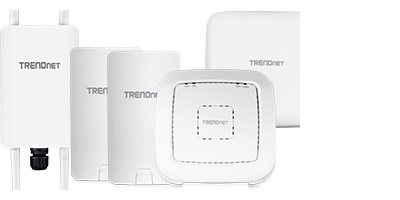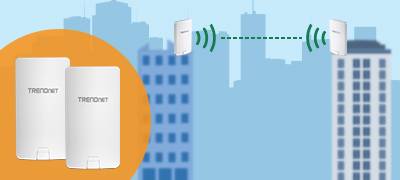Four Time-Saving Tips for Outdoor WiFi Access Point Bridge Installations
August 2022

Outdoor WiFi Access Points
Access points allow you to share a wireless signal by creating a wireless local area network (WLAN). They are ideal for use in areas where a wireless signal from your router may not reach. Unlike wireless range extenders, access points (AP) do not need to be within the wireless range of the router to share a wireless signal. Access points connect to a router or network switch via an Ethernet cable. (To learn more about wireless access points, click here).
Simply put, outdoor WiFi access points are access points that can be used outdoors. Outdoor WiFi access points usually have an IP rating that indicates how much dust or liquid that it can withstand. (To learn more about ingress protection (IP) ratings, see here). Outdoor WiFi access points are often used to wirelessly connect two or more locations together. In additional to outdoor wireless access point bridges, other uses include outdoor public WiFi, or automation controls

Indoor and outdoor WiFi access points
Outdoor Wireless Access Point Bridges

Outdoor wireless bridge
Outdoor WiFi access points, also known as a wireless distribution system (WDS), PTP (point-to-point) bridge, and PTMP (point-to-multi-point) bridge, are commonly used to connect two or more locations together. They are often incorporated into networked surveillance solutions, or for entrance and gate access controls. A larger solution can incorporate multiple remote access points for a point-to-multi-point solution for remote network expansion.
An outdoor wireless bridge solution is ideal for locations where a wired option is not available or prohibited. Even when a wired connection is possible, an outdoor WiFi access point system may be a much more cost-effective option.
Outdoor access point installations necessitate taking accurate measurements. Some people think that you can put up outdoor access points anywhere, but that’s definitely not the case. Setting up and installing wireless access points require specific steps to ensure that they work properly, and that they work well. Installing WiFi outdoor access point systems will also require specific physical mounting configurations in order to facilitate a reliable, long-distance wireless point-to-point or point-to-multi-point connection. Unlike what many people may think, wireless is not magic.
Here are four time-saving tips for installing a WiFi access point bridge:
- Conduct a Wireless Site Survey
Site surveys are required for any wireless deployment. You must visit the site location to conduct a site survey. Site surveys ensure you have enough wireless coverage planned for the project. For more information on site surveys, view our tips for how to conduct a wireless site survey. - Pre-Configure Devices & Pre-Test
Before heading back to the site to install the access points, set them up locally in your lab to configure and pre-test the APs. TRENDnet’s outdoor wireless access point kits are conveniently pre-configured and work out of the box. It is still recommended to pre-test the APs in your lab to look for any issues or defects. Test your APs at least 15 feet from one another. - Ensure Line of Sight
The outdoor WiFi access points must have a clear line of sight. This means there are no obstructions between the two APs. This includes buildings, trees, and hills. Without line of the site, the APs will not be able to create a solid connection. - Match the Elevation of the Access Points
Outdoor WiFi access points need to be at the installed at the same elevation and facing each other, at least 10 feet above ground. Both access points need to be high enough for line of sight and to eliminate obstructions. If access points are not at the exact height, make sure they are facing each other directly. APs most be pointed at each other to establish a wireless connection.

